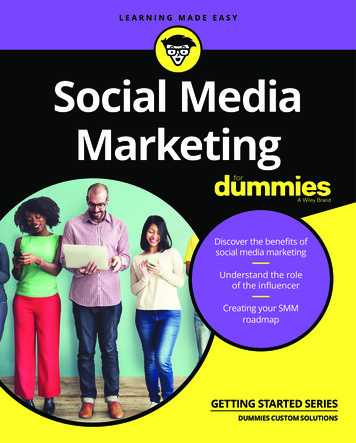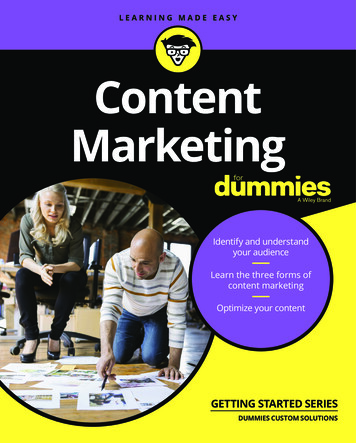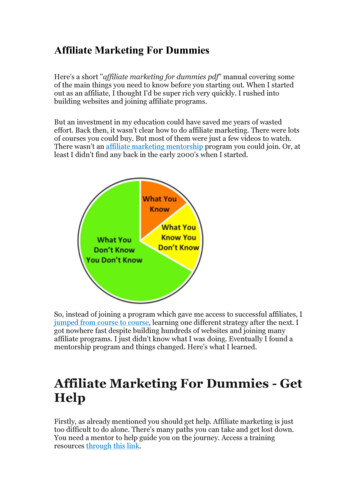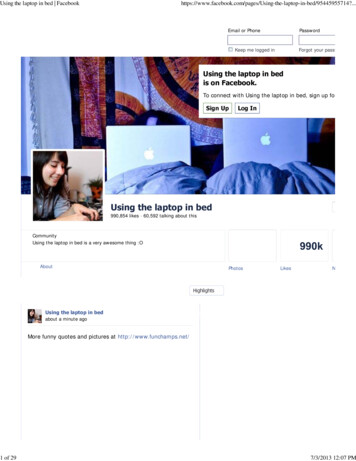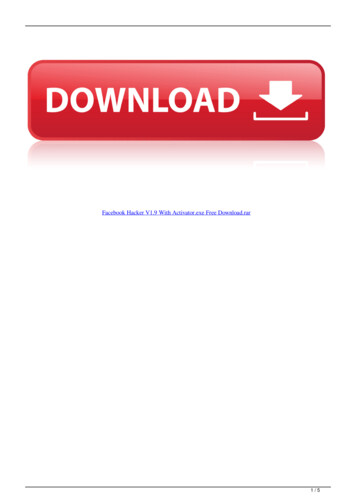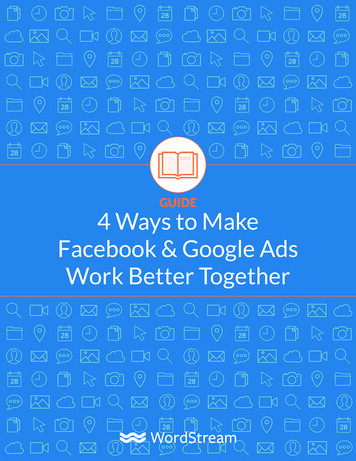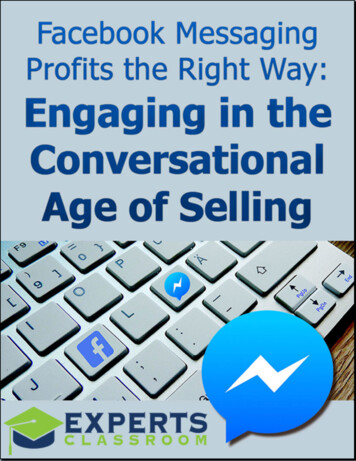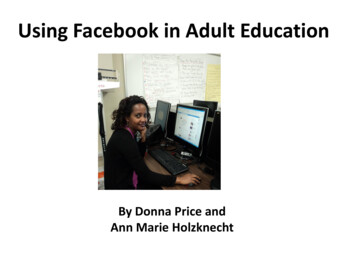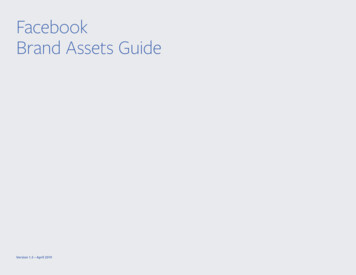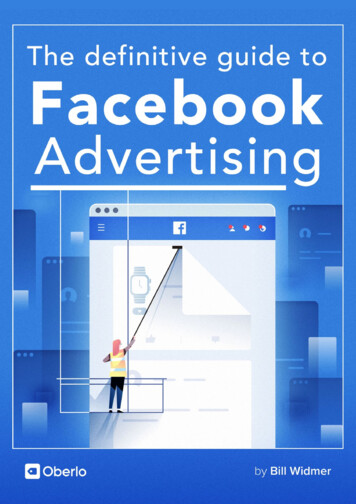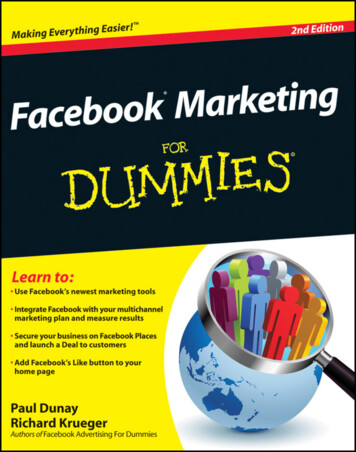
Transcription
Facebook MarketingFor Dummiesnd2 EditionChapter 1Marketing the Facebook WayISBN: 978-0-470-92324-5Copyright of Wiley Publishing, Inc.Indianapolis, IndianaPosted with Permission
Chapter 1Marketing the Facebook WayIn This Chapter Discovering Facebook as a marketing platform Integrating Facebook into your marketing mix Engaging fans through content Measuring your success Navigating Facebook’s changing currentsIf Facebook were a country, it’d be the third most-populated nation in theworld. Imagine being able to get your message in front of the Facebooknation for free. That is exactly what Facebook offers savvy marketers — anda whole lot more.Facebook is increasingly becoming an integral part of a company’s marketing strategy. Whether you’re a small business or large corporation, retailer,B2B (business to business) service provider, or consultant, you need to havea presence on Facebook. However, Facebook isn’t just the world’s largestsocial networking site; it’s extending its presence to your Web site by offering free software — social plug-ins — that enable you to employ many of thesame social Facebook features on your Web site. Major brands, such as CNN,TripAdvisor, and Levi Strauss & Co., were quick to leverage these featuresand have seen remarkable engagement (interaction) levels from their usersas a result. Fortunately, you don’t have to be a Fortune 500 company to takeadvantage of these features. Thousands of businesses — small and large —are finding ways to make these tools work for their Web sites.As Facebook has grown in scale to a size previously unimaginable, its influence as a new marketing channel is being felt across the Web. By extendingits platform to Web site owners with social plug-ins, Facebook has the potential to affect the way people market well into the future. One thing is for sure,marketers flock to the social network in huge numbers, attracted by its manypossibilities. For them, Facebook represents more than just another technodriven fad; it’s nothing short of a marketing revolution.In this chapter, we give you an overview of how you can utilize Facebook asa marketing platform for your business. We explain the importance of putting05 9780470923245-ch01.indd 912/22/10 9:44 AM
10Part I: Adding Facebook to Your Marketing Strategytogether a marketing plan and why you need to create a Facebook Pagefor your business. Finally, we introduce two tools to help you gauge theperformance of your Page and advertising campaign.Introducing Facebook asa Marketing PlatformAlthough practically everyone is familiar with Facebook, businesses are justbeginning to wake up to its potential as a marketing platform. With more than500 million members worldwide, Facebook far surpasses the potential reach ofany other media provider. Think about it: Every day, Facebook attracts morethan ten times the TV audience of the Super Bowl. That’s a lot of eyeballs.Facebook offers marketers a number of unique ways to interact with customers and prospects. Many, such as Facebook Pages, Groups, and Events,are free for any individual or business. In fact, the very same social features(such as News Feeds; comments; and the ability to share things like links,photos and videos, and updates) that have helped Facebook become a massphenomenon are transforming the way companies market themselves.Other paid opportunities — for example, Facebook Ads, which can be purchased on a cost per click (CPC) or cost per impression (CPM) basis — areincreasingly popular because they enable to you to reach as narrow or wide ofan audience as desired, often at a fraction of the cost of other online media outlets, such as Google AdSense. And because Facebook members voluntarily provide information about their personal interests and relationships (or friends),Facebook has a wealth of information about its members that advertisers caneasily tap into. (We discuss Facebook advertising in detail in Chapter 10.)The new Facebook marketing paradigm is rewriting all the rules. As marketersscramble to understand how best to leverage this powerful new communicationschannel, those who don’t jump on board risk being left behind at the station.Homesteading on a Facebook PageYou can hang a shingle out for your organization on a Facebook Page. APage serves as a home for your business — a place to notify people aboutan upcoming event; provide your hours of operation and contact information;show recent news; and even display photos, videos, text, and other types of05 9780470923245-ch01.indd 1012/22/10 9:44 AM
Chapter 1: Marketing the Facebook Way11content. Pages also allow you to carry on conversations with your customersand prospects, providing a new avenue for finding out more about what theywant from your business.Facebook Pages are visible to everyone online, regardless of whether thatperson is a Facebook member. For this reason, search engines, such asGoogle and Microsoft’s Bing, can find and index your Page, often improvingyour company’s positioning in search results.In the following sections, we give you the lowdown on what a Facebook Pageis and why your business needs one. (Chapter 4 goes into the details on howto create a Page.)Understanding the anatomy of a PageHere’s a look at some of the elements that make up a Facebook Page(see Figure 1-1): Wall: The Wall tab serves as the central component of a Page and allowsyou to upload content such as photos, videos, links, and notes. Theseactions generate updates and display as stories on your fans’ News Feeds. Like button: When someone clicks your Facebook Page’s Like button,she is expressing her approval of your Page. She becomes a fan of yourPage, and a story appears in her News Feed, which is distributed to herfriends who are then more likely to like your Page. (We discuss the Likebutton in detail in Chapter 14.) Status update box: This is the box with the What’s On Your Mind? text.(This box is not shown in Figure 1-1.) If you want to push out a message,you can send a status update. Pages allow you, the Page administrator(admin), to send a limitless stream of updates (short messages up to420 characters in length), which, in turn, appear in your fans’ News Feeds. Info tab: Here is where more detailed information about your companyis located including your location and Web site address. Discussions: Discussions are another feature that allows anyone tocreate a topic of conversation and permit follow-up comments. Memberscan add to any discussion by typing their comments in the appropriatebox and clicking the Post Reply button. Applications: You can customize your Page with a host of applications(apps). Facebook offers a wide range of apps that you can use on yourPage, anything from virtual business cards to RSS feeds from your favorite news services. (We discuss apps in detail in Chapter 12.)05 9780470923245-ch01.indd 1112/22/10 9:44 AM
12Part I: Adding Facebook to Your Marketing StrategyFigure 1-1:The anatomy of aFacebookPage, asdisplayed tousers.Why your business needs a PageThe Facebook Platform stands as one of the most powerful platforms forbusinesses since Google launched AdWords in 2001. Where else in reality —or on the Web — can you find some of the most connected and social peopleon the planet, all ready and willing to engage with you and your business?Better still, where can you find an ad platform that can target not only bykeyword (like Google can do) but also by age, gender, location, and personallikes and interests such as favorite types of music, movies, or food?Here’s a rundown of some key benefits to creating a Facebook Page foryour business: Get more attention from search engines: One of the best things about aFacebook Page is that the major search engines index it, so it can appearin search results for your company name within days. Both profiles andPages are indexed and considered a strong source of relevant contentin the eyes of the search engines. Much like a blog with frequent postsof fresh content, your Facebook Page will reap the benefits of increasedsearch engine traffic when your content is updated regularly. Tap into the social network: Another benefit of having a Page for yourbusiness is that anyone can find your business on Facebook in ways perhaps that you never dreamed of. Sure, they can find your business bydoing a search, but the real beauty of Facebook are the numerous ways05 9780470923245-ch01.indd 1212/22/10 9:44 AM
Chapter 1: Marketing the Facebook Way13that your business can be found just by being part of Facebook and updating your content regularly. Friends of fans can experience your businessby seeing any updates you post from your Page when they look at theirfriend’s News Feed. Fans can share your Page with others, thereby helpingyou to tap into a new audience for your business with their endorsement. Target a global digital audience: The Internet is global in nature, andanyone can find your business on the Web if they know what to lookfor. While Facebook’s membership keeps growing, you have an opportunity to get your business noticed by people across the globe. Thinkabout your ideal customer and the hobbies and activities that customerenjoys. If Web surfing and socializing sound like a fit for your audience,Facebook is the place for your business. Attract unlimited fans and potential new clients: Unlike a profile page,where Facebook limits the number of friends you can have to 5,000, yourcompany’s Facebook Page can have an unlimited number of fans. This iswhy you want to update your Page regularly with interesting content. Ifyou want to attract thousands to your Page, consider the quality of andthe frequency by which you can post content. This is the key to buildingyour fan base. Engage your audience: Facebook is free for everyone, so why wouldn’tyou want to have more traffic, more awareness, more fans, and more business as a result? Adding a provocative topic to your Page’s Discussionstab and inviting all your fans to comment actually allows your target audience to do some marketing for you because they can spread the word totheir friends, who may not yet be fans of your Page. In doing so, they actas a viral (word-of-mouth) accelerator to your marketing. Sync your company blog to your Facebook page: Creating compellingcontent is a challenge in all forms of social media and social networking.You want to be sure your content flows from one form of social media toyour other forms of social media. In other words, if you have a companyblog, synchronize it with your Facebook Page so that when you post toyour blog, the content also posts to your Facebook Page for yourFacebook audience to read. (See Chapter 4 for details.) Track fan promotions: When you have something to send to your entirefan base, you can do it with Facebook. This is a great way of reengagingfans with your business. If you want to run a promotion or send a discount to drive them to your offline store, you can do that. But don’t forgetto track your efforts so you can close the loop and monitor the effectiveness of the promotion. This could be as simple as collecting the couponcode you used; having a check box on an order form to gauge where thelead came from; or asking the callers, if they are calling into your callcenter, where they heard about the promotion. You don’t want to losethe opportunity to see how much business and return on investment(ROI) you can generate from this medium.05 9780470923245-ch01.indd 1312/22/10 9:44 AM
14Part I: Adding Facebook to Your Marketing Strategy Facilitate fan-to-fan interaction: Another important benefit of aFacebook Page is the ability to encourage fan-to-fan interaction. Whereelse can your fans engage in direct conversations with each other andyour company? This capability can be exceptionally helpful for businesses that sell complex products. Your Page can work as an outpostwhere fans can support each other by answering questions and providing tips on how to make your product work better. Moreover, yourPage can work like a year-round focus group. Use your Wall to generatevaluable feedback, and don’t forget to continue the conversation as youmove your fans down the sales funnel through conversion. Host a fabulous event: Using Facebook Events is a great way of getting people together virtually or in person to support your local business, brand, or product (see Figure 1-2). Setting up events throughyour Facebook Page is also an economical way of getting the word outbeyond your normal in-house marketing list by inviting the fans of yourPage. Fans can also help you promote your Facebook event to theirfriends by sharing the event if it seems of value to their friends.(We discuss events in detail in Chapter 7.)Figure 1-2:Publicizean event onyour Page. Promote a worthy cause: Take a tip from Lance Armstrong, the worldfamous cyclist, who is also known for his philanthropic activities. HisFacebook Page has more than 1.4 million fans. He brands himself relative to his expertise and what he’s known for, being a bicyclist and thefounder of LIVESTRONG. Armstrong provides up-to-date notices onhis latest races and appearances, videos, and pictures of his currentlocation and different athletic equipment that he likes.Social media is the perfect tool to unite fans around a cause that matters toyou. Be authentic, engaging, and true to your cause by updating your Pagefrequently with relevant information, such as links to news stories pertaining05 9780470923245-ch01.indd 1412/22/10 9:44 AM
Chapter 1: Marketing the Facebook Way15to the subject or photos from any charity events you may have attended. Thisshows your fans that you’re passionate about the cause and are involved on adeeper level than just through a Facebook Page.Developing Your FacebookMarketing StrategyBefore you run blindly into the eye of the Facebook storm, you need to havea plan. Achieving success marketing your business on Facebook doesn’thappen by accident; it requires a well-mapped plan and strategic approachthat takes many factors into consideration, including: Knowing your target audience Identifying objectives Developing a content strategy Creating a conversation calendar; in other words, who in your organizationis responsible for updates as well as what and when content will be shared Mapping a customer response plan, meaning how you’re going toanswer customer inquiries and any complaints that may come in Measuring results with the most salient dataWithout understanding your goals and objectives from the outset, you can’tpossibly know whether your efforts are succeeding. We go into detail abouthow to create a Facebook marketing plan in Chapter 3, but in general, youwant to keep these key points in mind when building your marketing plan: Know your audience: Who do you want to join your community, and whywill they want to join? These are two questions that must be answeredbefore you dive in. Where is your audience hanging out online? What dothey consider as their influences? Understanding who you’re marketingto is the most important factor in creating your plan, so you better get itright. Perhaps you have two or more distinct groups that make up youraudience; how do you address the needs of each respective target group?This might require you to segment your fans and enlist separate plans ofaction to manage the individual communities.05 9780470923245-ch01.indd 1512/22/10 9:44 AM
16Part I: Adding Facebook to Your Marketing Strategy Build relationships: Whether your objective is to sell more widgets, makepeople aware of your cause, or build credibility as an expert in a particular subject matter, it all breaks down to establishing a relationship withyour fans. In fact, in part thanks to Facebook, marketers must spend a lotof time thinking of how to build better relationships with their customers.Facebook allows your fans to find out more about your business, and justas importantly, it provides a two-way communication channel for you toget to know them. One of the best ways to establish a relationship is toshow your fans that you’re interested in what they have to say by listening and responding to their comments and concerns in a timely manner. Make your business likeable: Simply responding to your fans’ commentsisn’t enough. Facebook literally flips traditional push-pull marketing onits head. Instead of simply pushing out information in the form of advertisements or the customer pulling more information from a company byinitiating contact with them, Facebook allows its members to actuallychampion an organization, a celebrity, or virtually any business on thesite. From there they can proclaim their affirmation to all their friends viaa Page’s Like button. This presents both a tremendous opportunity andan incredible challenge for Facebook marketers: how to encourage yourtarget audience to like your Page. Although making your business likeable may seem shallow and simplistic on the surface, it needs to be atthe heart of any Facebook marketing plan. Focus on quality, not quantity: Chances are good that 10 percent ofyour fan base will be responsible for 90 percent of the activity on yourPage. A good Facebook plan takes into account ways to influence theinfluencers (the most vocal contributors). Rather than trying to be allthings to all fans, focus on building a smaller, more connected community at the outset. More times than not, this strategy outperforms onethat focuses on quantity over quality. Maintain your authenticity: In developing your Facebook marketingplan, you want to reinforce certain qualities and virtues, such as yourimpeccable customer service record or your commitment to creatingquality products. Whatever these might be, being true to what and whoyour organization stands for needs to shine through. Don’t pretend tobe something you’re not. Nobody likes a phony, and it’s easy to spotone within Facebook. Likewise, be transparent because in the end,there are very few secrets online. Incentivize your fans: This is the “what’s in it for you” factor. You need totreat your Facebook fans like they’re special. After all, who doesn’t like tobe treated, well, special. That might mean special discounts, access to limited merchandise, free French fries with every entrée, or the opportunityto download a free e-book. Your marketing plan needs to take into accountwhat’s attractive to your fans and how best to leverage that reward.Starbucks enlisted the help of Sarah McLachlan to treat its Facebookfans to a live concert, and its fans responded en masse to this onlineevent. In Figure 1-3, you see how the best content can also serve as agood incentive to engage fans.05 9780470923245-ch01.indd 1612/22/10 9:44 AM
Chapter 1: Marketing the Facebook Way17Figure 1-3:Starbucksintegrateslive eventsto keep fanscomingback to itsFacebookPage.Leveraging ContentFacebook is all about connecting and sharing. On Facebook, members connect with old and new friends, near and distant relatives, present and pastcoworkers, and people with similar interests or common interrelationships.However, the sharing part is what’s so exciting to marketers.Sharing is all about the content. Whether that content is videos, photos, comments, links, blog posts through your RSS feed, or likes, a whole lot of contentsharing goes on inside Facebook. In fact, more than 25 billion pieces of contentare shared each month among its members. The key to Facebook marketingsuccess can be summed up in three words: content, content, content.Here are some general points to keep in mind when sharing content onyour Page:05 9780470923245-ch01.indd 1712/22/10 9:44 AM
18Part I: Adding Facebook to Your Marketing Strategy Take into account how best to involve your audience. The fan engagement factor — getting your community emotionally involved, participating,and sharing — can help expand your audience. For example, in Figure 1-4,reality TV star and professional chef Bethenny Frankel shares a recipewith her fans. Here she asks a question of her fans and offers a good suggestion, complete with information on how to prepare the meal. Her fansexpressed great interest in the recipe, and some even responded withquestions or comments regarding their plan to make the salad, showingan even further level of engagement on their part.Figure 1-4:BethennyFrankel’sFacebookPage regularly postslinks to newrecipes andasks fans tocomment. Maintain a steady stream of updates; however, be careful to strike adelicate balance to not overwhelm your fans. At a certain point, an overlyenthusiastic update strategy could be viewed as spam and turn away yourfan base, who can easily hide the flow of updates from your Page.Updates are short messages that are sent by the Page admin and appearin your fans’ News Feeds. Other pieces of content, such as links andphotos, can be attached to the updates. Create a schedule for your posting updates. Just as a magazine follows aneditorial calendar, Facebook marketers need to create a conversation calendar, detailing who in your organization is responsible for updates as well aswhat and when content will be shared. Also include room for spontaneity,personality, and current events. Some of the most successful, engagingupdates a business can make may have nothing to do with business. Forexample, home improvement retailer Lowes regularly asks questions of itsfans such as “Indoors or outdoors?” Around Halloween time, Lowes asksits fans, “Anybody in your house — big people or small — dressing up forHalloween? As what?” Not only is this a change from home improvementrelated content, but it also engages fans with the store — and each other.For more on creating and implementing a content strategy, see Chapter 5.05 9780470923245-ch01.indd 1812/22/10 9:44 AM
Chapter 1: Marketing the Facebook Way19Who’s in charge here?Facebook requires dedicated resources andsupport at all levels of the company. However,someone needs to take ownership over the dayto-day responsibilities of managing an organization’s Facebook community instead of thesedecisions being made by a group or committee.Individuals can respond much quicker in thisinstant feedback environment. Whether thatindividual is the CEO, a college intern, or anoutside agency, you need a clear line of command when dealing with who’s in charge of yourcompany’s Facebook presence. A key thing toremember, though, is that whoever takes thereins of your Page must have a clear understanding of your brand messaging and the tonethat their updates must have. Consistency is key.Incorporating Analytics into Your PlanAfter you put together a marketing plan and decide what content you wantto share, you need to focus on the metrics, or key performance indicators,to determine what level of success you’ve achieved. Your metrics are partlydictated by your goals. For example, if your goal is to acquire new customers,you may want to look at how many of your Web site’s contact forms werecompleted by people looking for more information, and the total number offans for your Page. Or if your goal is to focus on providing existing customers with superior customer service, you need to look at how many commentsand responses were made by your customers.Using InsightsFacebook offers new and improved tools for tracking your Page’s performance — Insights. Facebook Insights provides plenty of analytics to understand who visits your Page; where those folks come from; and what they dowhile there, such as comment on a post, click a link, or watch your videos.Facebook Insights is available to all Page admins after you have 30 fans of yourPage, and it provides graphs and charts that make it easy to analyze trends inyour Facebook Page’s traffic. A host of tools includes the ability to visualize thedata in different ways. These graphs can all be downloaded to your computerso you can show your boss how your Page performs. In Figure 1-5, the InsightsDashboard shows fan activity and the number of likes and comments in easyto-understand graphics. (See Chapter 9 for more on Insights.)05 9780470923245-ch01.indd 1912/22/10 9:44 AM
20Part I: Adding Facebook to Your Marketing StrategyFigure 1-5:FacebookInsightsprovidegraphs andmetricsthat tracka Page’sperformance.Measuring ad performancewith the Ads ManagerFacebook provides a full set of analytics to help you track your Facebook adperformance. You can view your ad analytics with Facebook’s Ads Managerat www.facebook.com/ads/manage. Figure 1-6 shows an example of whata current campaign looks like in the Ads Manager. It shows which campaignsare active and paused, the ad budget, the number of impressions it hashad, the social percentage and its average cost (based on CPC or CPM),the number of clicks and impressions, the click-through rate (CTR), andthe total amount spent per campaign.To find out how to use the Ads Manager to track the performance of yourads, check out Chapter 10.05 9780470923245-ch01.indd 2012/22/10 9:44 AM
Chapter 1: Marketing the Facebook Way21Figure csfor yourpaused andactive adcampaigns.Adapting to Facebook ChangesOne caution as you enter the world of Facebook marketing: Facebook isan ever-changing universe, and some of the features and guidelines you’vegrown to rely on could be in jeopardy with every new design iteration andpolicy change. You need to build in contingencies to account for potentialshifts in technology and policies. Entire ad formats have been announced,launched, and died an early death just when you thought they’d be idealfor your next ad campaign.Although many Facebook changes are cosmetic in nature, many refinementstake place in regards to the data made available to marketers, the policiesthat apply to member privacy settings, and what and to whom you can advertise. Remember that marketing on Facebook is an evolutionary process, andyour marketing plan will forever be a work in progress.Staying on top of Facebook developmentsIt is very important to keep up to date on recently made and upcomingchanges to Facebook’s policies and regulations. This is especially important ifyou plan on running promotions using the Facebook Platform, as discussed in05 9780470923245-ch01.indd 2112/22/10 9:44 AM
22Part I: Adding Facebook to Your Marketing StrategyChapter 7. There are specific procedures you must adhere to so that you canrun a promotion on your Page. If you don’t follow Facebook’s stringent guidelines, your account may be suspended or — even worse — deleted altogether.Some good sources for the most current information on what’s new andimproved at Facebook is its blog located at http://blog.facebook.com and the Notifications section at the top of your Ads Manager (refer toFigure 1-6). While you’re at it, why don’t you become a fan of Facebook’sown Page located at www.facebook.com/facebook? Not only do the goodpeople at Facebook update their content frequently (maybe they’re readingthis book just like you!), but they also have numerous tabs on their Page thatoffer some creative ideas that you may want to incorporate into your ownPage. Facebook Live is one such idea. This is the live-streaming channel outof Facebook’s California headquarters featuring discussions on the latestcompany innovations and events as well as demos of the newest features.Navigating unchartered waters can be difficult. Facebook is notorious for rolling out sweeping changes, often with profound implications for marketers. Butif you check in regularly with Facebook’s marketing Pages and glance at theblogs and news sources that report on Facebook, you’ll have a good senseof the wind of change before it blows.Addressing growing privacy concernsAnother factor that needs consideration in your marketing plan is the privacyconcerns that continue to plague Facebook. These range from legislativeattempts to ensure that Facebook guarantees a certain level of privacy rightson behalf of its members, to backlash from members seeking to protect theirpersonal information. You need to understand and be able to adapt to bothFacebook’s privacy guidelines as well as your fans’ changing expectations.This is a hotbed issue, one that will no doubt remain a thorn in Facebook’sside. Marketers need to address these concerns while adopting policies thatensure their fans’ rights are respected.05 9780470923245-ch01.indd 2212/22/10 9:44 AM
Cartoons at a GlanceBy Rich Tennantpage 57page 159page 7page 249page 193Cartoon Information:Fax: 978-546-7747E-Mail: richtennant@the5thwave.comWorld Wide Web: www.the5thwave.com02 9780470923245-ftoc.indd ix12/22/10 9:41 AM
02 9780470923245-ftoc.indd x12/22/10 9:41 AM
Contents at a GlanceIntroduction . 1Part I: Adding Facebook to Your Marketing Strategy . 7Chapter 1: Marketing the Facebook Way . 9Chapter 2: Focusing on Facebook Features. 23Chapter 3: Developing a Facebook Marketing Plan . 37Part II: Building Your Facebook Presence . 57Chapter 4: Creating a Page for Your Business . 59Chapter 5: Implementing a Content Strategy . 79Chapter 6: Building Your Fan Base . 93Chapter 7: Setting Up Groups, Promotions, and Events . 111Chapter 8: Cross-Promoting Your Page . 129Chapter 9: Measuring Your Page Activity . 147Part III: Engaging in Facebook Advertising . 159Chapter 10: Checking Out Advertising Options and Strategies .
Chapter 1: Marketing the Facebook Way 11 content. Pages also allow you to carry on conversations with your customers and prospects, providing a new avenue for finding out more about what they want from your business. Facebook Pages are visible to everyone online
